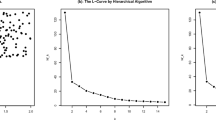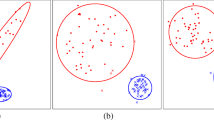Abstract
In the cluster analysis, to determine the unknown number of clusters we use a criterion based on a classical location test statistic, Hotelling’s T 2. At each clustering level, its theoretical threshold is studied in view of its statistical distribution and a multiple comparison problem. In order to examine its performance, extensive experiments are done with synthetic data generated from multivariate normal distributions and a set of real image data.
Preview
Unable to display preview. Download preview PDF.
Similar content being viewed by others
References
Benjamin, Y., Hochberg, Y.: Controlling the False Discovery Rate: a practical and powerful approach to multiple testing. J. R. Statist. Soc. B 57(1), 289–300 (1995)
Choi, K., Jun, C.: A systematic approach to the Kansei factors of tactile sense regarding the surface roughness. Applied Economics (in press, 2006)
Duda, R.D., Hart, P.E., Stork, D.G.: Pattern Classification. John Wiley & Sons, Inc., New York (2001)
Gallegos, M.T.: Maximum likelihood clustering with outliers. In: Jajuga, et al. (eds.) Classification, Clustering, and Data Analysis, Springer, Heidelberg (2002)
Gordon, A.: Classification, 2nd edn. Chapman and Hall-CRC, London (1999)
Hastie, T., Tibshirani, R., Friedman, J.: The elements of statistical learning. In: Data Mining, Inference, and Prediction, Springer, Heidelberg (2001)
Hotelling, H.: Multivariate Quality Control. In: Eisenhart, C., Hastay, M.W., Wallis, W.A. (eds.) Techniques of Statistical Analysis, McGraw-Hill, New York (1947)
Ihaka, R., Gentleman, R.: A language for data analysis and graphics. Journal of Computational and Graphical Statistics 5(3), 299–314 (1996)
Jajuga, K., Sokolowski, A., Bock, H.-H. (eds.): Classification, Clustering, and Data Analysis. Springer, Heidelberg (2002)
Kim, D.H., Chung, C.W., Barnard, K.: Relevance Feedback using Adaptive Clustering for Image Similarity Retrieval. The Journal of Systems and Software 78, 9–23 (2005)
Mardia, K.V., Kent, J.T., Bibby, J.M.: Multivariate Analysis. Academic Press, London (1979)
Miligan, G.W., Cooper, M.C.: An examination of procedure for determining the number of clusters in a data set. Psychometrika 50, 159–179 (1985)
Mojena, R.: Hierarchical grouping methods and stopping rules: An evaluation. The Computer journal 20(4) (1975)
Rencher, A.C.: Methods of Multivariate Analysis. John Wiley and Sons, Chichester (2002)
Rousseeuw, P.J., Van Driessen, K.: A first algorithm for the minimum covariance determinant estimator. Technometrics 41, 212–223 (1999)
Tibsirani, R., Walther, G., Hasite, T.: Estimating the number of clusters in a data set via the gap statistic. J.R. Statist. Soc. B 63, 411–423 (2001)
Ward, J.H.: Hierarchical Grouping to optimize an objective function. J. of Amer. Stat. Assoc. 58, 236–244 (1963)
Author information
Authors and Affiliations
Editor information
Editors and Affiliations
Rights and permissions
Copyright information
© 2006 Springer-Verlag Berlin Heidelberg
About this paper
Cite this paper
Choi, K., Kim, DH., Choi, T. (2006). Estimating the Number of Clusters Using Multivariate Location Test Statistics. In: Wang, L., Jiao, L., Shi, G., Li, X., Liu, J. (eds) Fuzzy Systems and Knowledge Discovery. FSKD 2006. Lecture Notes in Computer Science(), vol 4223. Springer, Berlin, Heidelberg. https://doi.org/10.1007/11881599_43
Download citation
DOI: https://doi.org/10.1007/11881599_43
Publisher Name: Springer, Berlin, Heidelberg
Print ISBN: 978-3-540-45916-3
Online ISBN: 978-3-540-45917-0
eBook Packages: Computer ScienceComputer Science (R0)




